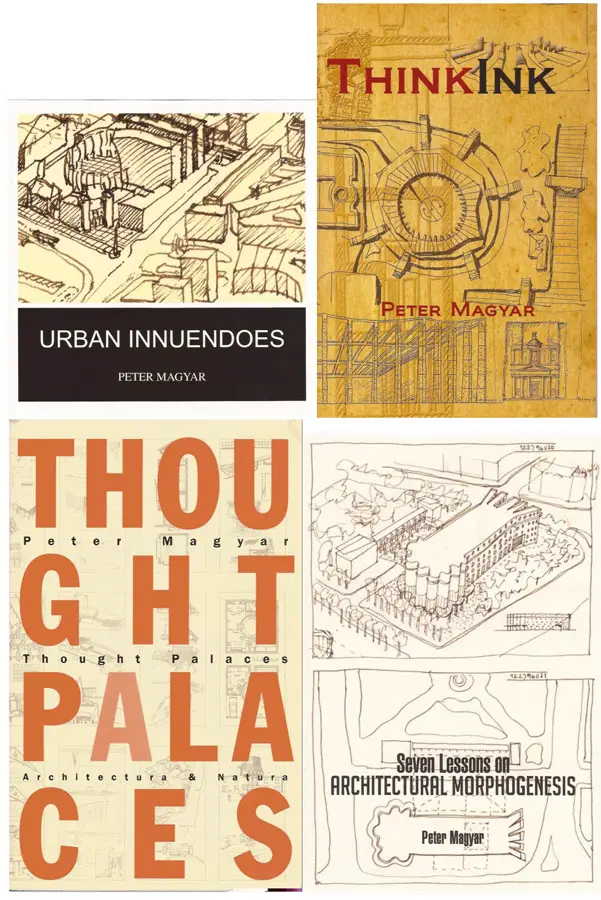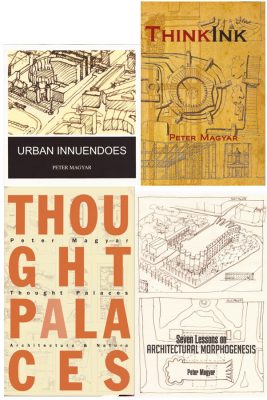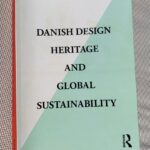Urban Innuendoes Book, Peter Magyar Publication, Architect, Architecture
Urban Innuendoes : Peter Magyar Book
US Architectural Publication – Seven Lessons
26 Mar 2013
Architectural Morphogenesis
New Book by Peter Magyar
Seven Lessons on ARCHITECTURAL MORPHOGENESIS
It is the author’s fourth extensive book on drawings in architectural design. It follows “Thought Palaces” (1999), “Thinkink” (2010), and “Urban Innuendoes” (2013). All these books favored drawings as compared to text, but this book has no written text at all (with the exception of the acknowledgements and the contents page). Its motto is, drawings speak many tongues they form the text of this book.
It contains seven architectural projects, all designed by the author. They are all international competitions about complex and significant public buildings. None of his winning projects are among them because the purpose of the book is to provide insights related to the secrets of the intuitive and rational process of the thoughts – to – matter transformation. All the freehand ink drawings are made by the author, using the spaceprints method.
Peter Magyar Book – external link
28 Jan 2013
Urban Innuendoes
Peter Magyar
URBAN INNUENDOS: THE UNFINISHED ELEVEN hosts eleven different architectural design processes, mostly, in the conceptual phase, accomplished at different times for various clients, using the same method.
It is noteworthy that the verbal text is kept at a tolerable minimum as interested persons are asked to read or interpret the drawings as they progress “as a first degree differentiation from spirit to matter.” Intuition and rational thinking are presumed to function throughout whole the process.
Urban Innuendoes book cover:
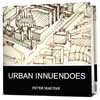
image from publishers
In addition, the depicted surfaces (the “Spaceprints”) provide the opportunity to simultaneously explore, analyze, and articulate the shape of space and nonspace. Both urban (macro) and building (micro) scales are developed in tandem, which is the most important observation, and the actual reason, of the book. All ink drawings are made by the author.
Introduction for Urban Innuendoes – Book review by Kendra Schank Smith
The drawings in Peter Magyar’s newest book, Urban Innuendoes, are remarkably reflective. They comprise an elegant combination of past and future. As inspired archeology, they represent a conversation between creative innovation and drawings that appear fractured and incomplete. In this way, the memories of the drawer inspire the invention.
We are reminded of thoughts by Wolfgang Meisenheimer in Daidalos 25, when he writes about poetic drawings that try to depict the indefinable. They are “… traces of the memory and the dreams of the drawer, outbreaks of temperament and wit, provocation of the observer, riddles, vague evocations or gestures of philosophical thesis … The transferals and interpretations which result from them move on all possible levels.” Most importantly, Dr. Magyar’s drawings cause the viewer to participate; to engage the questions they ask and to continually contemplate their meaning.
This is the power of drawings in that they can be insightful, contemplative, profound, playful and serious, all at the same time. The levels of understanding can represent past, present and future, but also they question architectural space, volume and context woven into aspirations and potentialities. The ability of these drawings, by Dr. Magyar, to “move on all possible levels” is their strength.
The assured and controlled lines, of these drawings, describe thoughtful urban interventions. Looking to future environments, the drawings are parturient in that they hold potentialities. Parturient suggests bringing forth or giving birth to something. The word evokes both the anticipation of a birth and production of something such as an idea or discovery.
In Urban Innuendoes, each drawing provokes expectations of a unique solution to a question of urban context. These drawings can be both universal, giving us suggestions of ways to think about context common to all cities, and at the same time, specifically addressing design for the future. The speculative buildings provoke contemporary solutions to design issues.
To ‘bring forth’ relies on something exciting just below the surface, evoking the emergence of the bold and new. Anticipation, of the thing about to be born, is fraught with ambiguity, but a certain amount of vagueness is not to be avoided. Actually, the ambiguity of these drawings encourages the observer to ponder. To ponder is to actively engage in imagination and contemplation. As a play on words, these drawings call upon us to ponder the profound.
The human mind will always attempt to find order out of chaos and it is this activity that provokes the viewer to look longer – to revel in the possibilities. As viewers, we cannot passively observe, we are compelled to actively associate and speculate. The drawings cause a certain willed reality. By actively engaging their speculative narrative, they bring the observer to ‘see’ the future. The seeing is not a ‘realistic’ view but rather a view with greater depth, a view that requires effort and imagination.
Dr. Magyar’s drawings are not chaotic, they are instead engaging. The lines both contemplative and quick (containing wit) encourage consideration. With the process of meditation, associations will ruminate and new notions can transpire. Again, to transpire questions the emergence of new ideas, and parturient potential. This is not all speculation, as the lines act as the narrative.
Drawn in sepia ink, the marks on the paper show a degree of transparency in some places and the denseness of hesitation in others. All the drawings use one type of pen, and one line weight, that indicates an evenness of tone. Although the consistency forces the viewer to question the emphasis of one element over another, this is the beauty of the drawings in that they give credibility to the whole. The even treatment places the designs perfectly within their context, since the buildings are considered part of their site even before they are built.
Again, we are reminded of archeology, as the broken edges provide the opportunities to look underneath, behind and around. This is where the drawings satisfy on many levels, they provide questions and solutions at the same time. The lines tell the story; they effectively frame the narrative and consequently become ‘thinking lines.’ As a result, this is where analysis and speculation meet, the place where the pondering of the past touches the design solution.
Parturient also evokes connotations of labor. The labor in Dr. Magyar’s drawing is not a labor of toil, but rather a labor of commitment. To ‘dig’ deeply into his memory, and his psyche, provide the foundation for anticipation of architectural expression. Grace McGarvie writes that “an architect is the drawer of dreams.” By ‘dreams’ we can expect that she meant the dreams of our sleep, but also the aspirations of our responsibilities as architects.
To envision the future is no small task, as it is bound up with memory, imagination and fantasy. The reader will not be able to draw easy conclusions about the drawings in this book, but will be compelled to return to the questions that are raised in the projects. Peter Magyar’s drawings, so beautifully reproduced in Urban Innuendoes, are the diagrams of these narratives, both of memories and speculation. They are part of the act of bringing architecture ‘to life.’
Review of ‘Urban Innuendoes’ publication, by Peter Magyar, written by Kendra Schank Smith, Ph.D., MRAIC, Ryerson University
Dr. Peter Magyar
The guest editor of this issue of e-architect is Dr. Peter Magyar, RIBA., an International educator, architect and author. Since 1989 he has been head and director of three Architectural Departments, or School, at the Penn State, Florida Atlantic and Kansas State Universities respectively. He is interested in the intuitive and cognitive processes of design, archived thousands of drawings in this field, some of them are published in his latest books: “Thought Palaces”, 1999 Architectura & Natura Press, and “ThinkInk”, 2010, Kendall Hunt. About a drawn Explanation of “Spaceprints” visit You Tube, and search for: video.
Drawings by Dr. Peter Magyar on e-architect:
Episodes by Water
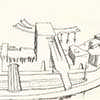
picture from architect
Peter Magyar: Urban Innuendos
The anticipatory pen : Drawing as the unveiling of the intuited world
‘Urban Innuendoes’ – Book review by Wilfried Wang
The magic of creativity is one of the most potent forces drawing people to architecture. Few phenomena are as fascinating as the translation of an idea into matter. Making something out of seemingly nothing; imaging a shape out of something amorphous through the interplay of hands.
Playing in sandboxes, making shapes from twigs: which child does not have happy memories of those imaginative times when there were no limits, no external clients, no programs, no cost constraints, no building codes, no schedules, just the world of discovery and self-discovery, of bringing to life and giving meaning to apparently shapeless matter. Later crayons, pencils, brushes and pens are pushed, scratched and drawn across walls, pieces of scrap paper to represent something, and, which one of us does not remember that sacred and fearful moment of drawing on some fine paper.
The process of drawing is thus the refined version of molding amorphous mass into form, of taming a line into a shape, of delineating an edge of a space into an element of architecture. The eyes see what the mind and the heart have intuited and the hand with the pen as its extended instrument unveils: a fantastic world as yet unbuilt but ready to be inhabited by imagination.
Perhaps it is the communication of such moments of euphoria, the adult term for happiness, that distinguishes successful designers. Even at a mature age, such charismatic individuals retain something of these moments of satisfaction and these senses of reward when, after arduous research and elaboration, a design has matured and is about to move into the contract stage, and the architect is still able to retell the story of the design’s genesis with an infectious enthusiasm.
Anyone who has watched Peter Magyar’s videos, in which he draws like a clairvoyant, assuredly leading his pen in the right direction, stopping it short to ensure that a superimposing element will not be “undermined” by an object that from the viewer’s position lies beneath, resuming the line on the other side of that obscured element to gradually complete the complex form that seems only to exist in Peter Magyar’s mind, anyone who has watched this will be amazed and inspired at the same time.
How easy the creation of architecture can be! Of course, it is all an elegant illusion and an exception. Few architects are able to draw like Peter Magyar. Fewer still are able to develop designs from step to step, to look at the final design from all sorts of different angles, to do cut-away sections, exploded axonometrics and so forth.
His rare skills have been acquired after patient practice, like that of a calligrapher. Each day, a calligrapher retraces the same lines. For musicians, this is nothing new. It is part of practice that makes perfect. Technique and meaning become one. It is as if one needed to draw and redraw in order to appreciate what lies in and beyond the lines. The lines are both precise in their thickness and in their beginning and end points. At best, the lines themselves dematerialize and become entirely dissolved in the figure that they outline. Like the notes in sheet music that dissolve in the sounds that in turn transform into a momentary atmosphere.
Each drawing, each element of architecture, each building and each urban element thus is merely a stepping stone towards a larger whole. And this larger whole is mostly considered as a three dimensional object. A banal thing to say, however, given Peter Magyar’s “normal” mode of representing his designs, the building’s plasticity implies that he thinks of forms, spaces and spatial sequences such as paths and circulations patterns. Staircases that envelop a form, lining the inside of a courtyard, continuing around the perimeter of a building come quite “naturally”. For other designers, who think essentially in plan or even in section, such three dimensional sequences do not come naturally.
Besides the abstract issue of plasticity, Peter Magyar’s view of architecture, in particular the view of his designs, raises the issues of figuration and symbolism. While hardline modernists would deny the relevance of these two formal possibilities, Peter Magyar delves into them with exploratory delight. Forms acquire meaning without crude recourse to metaphors or iconographic allusions. Peter Magyar’s designs become complete in the sense of bringing together the eidetic quality of the figure in the overall shape of a building, the spatial sequences and the tectonic structure.
Quite alike Arachne’s skills of weaving, Peter Magyar’s thread of the drawn line is spun to cross the different morphological orders, creating an architectural texture, whose verisimilitude might equally have irked Athena.
Review of ‘Urban Innuendoes’ publication, by Peter Magyar, © Wilfried Wang, Berlin 20 Jun 2012
Architectural Design
European Architecture Walking Tours : city walks by e-architect
Architecture Design Books – chronological list of publications
Architectural Articles by Dr. Peter Magyar
Architecture Masters : article by Dr. Peter Magyar. 2 Oct 2012
Architect Engineer Artist : article by Dr. Peter Magyar. 20 Mar 2012
Architectural Aura : article by Dr. Peter Magyar. 24 May 2011
Invention in Architecture : article by Dr. Peter Magyar. 7 Dec 2010
Architecture Books
Contemporary Architecture Publications
Comments / photos for the Urban Innuendoes Book – Peter Magyar Publication page welcome

